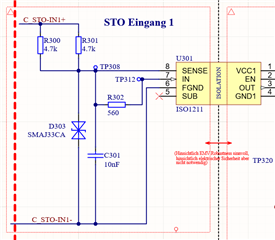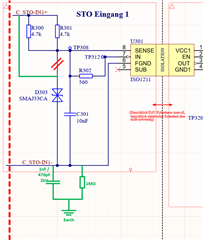Tool/software:
Dear sir or madam
In an STO application (safe torque off) we implemented two ISO1211 for the input signals. As the maximum length of the STO input cables are limitted to < 30m withstanding of surge tests is not required. Therefore we build up the input circuit with a 2.35k resistor for the threshold definition, a 560R resitistor for current definition, a 10nF capacitor for noise reduction and a TVS diode (33V Breakdown Voltage) for overvoltage / transient protection according information from the datasheet. (datasheet figure 22) According the informaiton given in the datasheet the circuit should withstand fast transient pulses as well as ESD pulses. Unfortunately, ESD pulses destroyed the input of the ISO1211 isolators.
According the information in the datasheet capacitors from the negativ signal input line to earth would help to withstand fast transient pulses, ESD pulses and surges (recommende for withstanding of surge pulses, even surge tests are not required for this design) according figure 23 in the datasheet.
Is there any experience or assumptions why the current design got destroyed by ESD pulses of an amplitude of 2kV?
Are there any sticking points / good tips and tricks on how the circuit could be made more resistant regarding fast transient pulses and ESD pulses?
Would the implementation of capacitors between the negative signal lines and earth be an option? If so, what are the advanteges and disadvanteges of this?
Many thanks in advance for your feedback.
Best regards Iwan Briker



